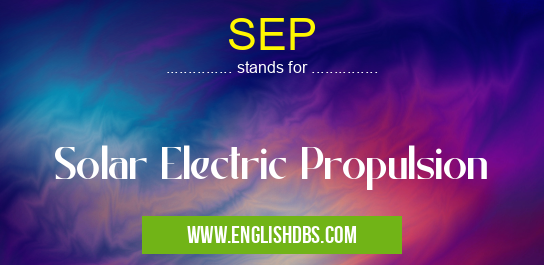What does SEP mean in ELECTRONICS
SEP is an acronym that stands for Solar Electric Propulsion. It is a type of spacecraft propulsion system that uses the power of the sun's rays to generate electricity, which is then used to power an electric thruster. Electric thrusters are much more efficient than traditional chemical rockets, and they can provide continuous thrust for long periods of time. This makes SEP ideal for missions that require long-duration, low-thrust maneuvers, such as station-keeping, orbit raising, and interplanetary travel.

SEP meaning in Electronics in Academic & Science
SEP mostly used in an acronym Electronics in Category Academic & Science that means Solar Electric Propulsion
Shorthand: SEP,
Full Form: Solar Electric Propulsion
For more information of "Solar Electric Propulsion", see the section below.
How Does SEP Work?
SEP systems typically consist of three main components:
- Solar arrays: These arrays convert sunlight into electricity.
- Power processing unit (PPU): The PPU regulates the flow of electricity from the solar arrays to the thruster.
- Electric thruster: The thruster uses the electricity from the PPU to generate thrust.
Electric thrusters work by accelerating a propellant (usually xenon or krypton) to very high speeds. The propellant is ionized, and the ions are then accelerated by an electric field. This creates a stream of charged particles that provides thrust.
Advantages of SEP
SEP has several advantages over traditional chemical rockets, including:
- High efficiency: SEP systems are much more efficient than chemical rockets, and they can provide continuous thrust for long periods of time.
- Low fuel consumption: SEP systems use much less fuel than chemical rockets, which can be a significant cost saving.
- Environmental friendliness: SEP systems do not produce any harmful emissions, making them a more environmentally friendly option than chemical rockets.
Applications of SEP
SEP is being used on a variety of spacecraft missions, including:
- Station-keeping: SEP is used to keep satellites in their desired orbits.
- Orbit raising: SEP is used to raise satellites to higher orbits.
- Interplanetary travel: SEP is used to propel spacecraft to other planets and moons.
Essential Questions and Answers on Solar Electric Propulsion in "SCIENCE»ELECTRONICS"
What is Solar Electric Propulsion (SEP)?
Solar Electric Propulsion (SEP) is a space propulsion technology that utilizes electricity generated from solar arrays to power an electric propulsion system. Unlike chemical propulsion, which relies on combustion of propellants, SEP employs electrically charged ions (charged particles) to generate thrust.
How does SEP work?
SEP systems consist of three main components: solar arrays, a power processing unit, and an electric thruster. The solar arrays convert sunlight into electricity, which is then processed and regulated by the power processing unit. The electric thruster uses the processed electricity to ionize and accelerate propellant ions, creating a stream of charged particles that provide thrust.
What are the advantages of SEP?
SEP offers several advantages over chemical propulsion, including:
- High specific impulse: SEP systems have a higher specific impulse (measure of propellant efficiency) than chemical propulsion, resulting in greater fuel efficiency and longer mission durations.
- Precise control: Electric thrusters can be precisely controlled, allowing for precise maneuvers and station-keeping operations.
- Long operational lifetime: SEP systems can operate for extended periods due to the absence of mechanical moving parts.
- Compatibility with low-Earth orbit: SEP is well-suited for use in low-Earth orbit (LEO) environments, where frequent maneuvers and attitude control are required.
What are the applications of SEP?
SEP is primarily used for:
- Satellite orbit insertion and maintenance
- Attitude control
- Deep-space missions
- Interplanetary transfers
- Science exploration missions
Final Words: SEP is a promising technology that has the potential to revolutionize space travel. Its high efficiency, low fuel consumption, and environmental friendliness make it an ideal choice for a variety of spacecraft missions. As SEP technology continues to develop, it is likely to play an increasingly important role in space exploration.
SEP also stands for: |
|
| All stands for SEP |
